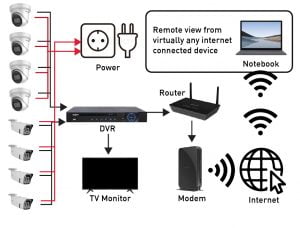Video Security Verification Systems: How Security Verification Video Footage Helps to Prevent Crime and Saves Money for Businesses
Security alarm systems have a huge influence on preventing crime and capturing criminals in the act. As a company, you have a variety of options at your disposal, like as video cameras, monitoring services, and motion sensor cameras. Because having 24/7 monitoring is expensive, many businesses choose monitoring that activates only when an alarm is triggered or no monitoring at all.
This causes a widespread problem known as false alarms, which has several negative consequences.
False alarms are expected to cost from citizens, businesses, and law enforcement 95% of the time. When an incident occurs at your organization, a video verification system is the best method to avoid false alarms and properly alert police authorities.
What Is a Video Verification System?
Your security monitoring provider may use verification video to provide visual evidence that someone is on your property when they shouldn’t be. Following a security breach, standard procedure is to notify the principal contacts first, followed by the police. Law enforcement organizations, like company owners, want to catch criminals in the act. They can reply rapidly because of the precision given by video verification.

How Does Video Verification Work?
A video verification system works with motion sensors on doors and windows, which trigger most burglar alarm systems. When one or more motion sensors are triggered, security cameras are activated. Your alarm company monitoring specialist will access the on-site camera, check if an intruder is present from their central monitoring station, and contact authorities with the information. With most security camera systems, video may also be reviewed and watched by on-site or off-site company staff.
Why is Alarm Verification Important
Traditional burglar alarms typically only provide law enforcement with the name of the business, address, and the location of the triggered alarms. This doesn’t give police enough information to determine the appropriate response.
The Most Common Sources of False Alarms
With an estimated 95% of alarm activations being false alarms, a solution to this problem is desperately needed.
The following are three of the most typical reasons of false alarms:
Improper Installation & Faulty Equipment: One of the leading causes of false alarms is faulty equipment or installation. Most installers utilize reliable equipment, however bad installation that is not tailored to the environment might result in unsatisfactory outcomes. False alarms are more likely to occur with DIY home security setups.
Employees or even company owners who are unfamiliar with their new security system might cause false alerts. Training your essential personnel on arming and deactivating the alarm system, and prepare for when it fails or an employee has difficulty arming it.
Loose objects and pets are major causes of false alerts in households, while wild animals may trigger false alarms in businesses. Pet movement may be ignored by sophisticated motion sensors from firms such as Fortress and Amtek. Secure any loose things that could move throughout the night to prevent false alarms.
Human errors is unavoidable in business, and in life in general. This may be taken into consideration with video verification, preventing company owners from obtaining penalties and wasting police resources due to harmless errors.
What You Should Talk About With Your Security Camera Installation & Monitoring Company
We recommend that you address the following things with your installer before installing a camera system:
Inquire with your installer if the system has video verification capabilities or if it can be updated to add it.
Compare and contrast continuous live stream monitoring with a video verification system. Live monitoring CCTV or IP cameras, for example, are more costly and need more human resources to manage.
Discuss with your monitoring company’s typical response time. Criminals may enter and exit your premises in a matter of minutes, thus the time it takes for your monitoring firm to be notified and for them to call the authorities should be limited to a few minutes.
Finally, talk about specific features that may be added to your security system while staying inside your budget. Extra illumination, loudspeakers, and closing/opening doors may all help to deter and catch offenders. Video verification may be used with card/fingerprint scanners.
Conclusion
Businesses who do not have a video verification system are more likely to be frustrated by the additional expense and/or lack of efficacy of their security system. Increased expenses for law enforcement and insurance firms might be passed on to you. However, the financial and emotional losses caused by a crime may never be recovered. If you wish to avoid this, contact the our professional security experts at 98556824 to discuss on establishing a video verification system for your business.
Find Out More:
Contact us at: https://wa.me/6598556824
